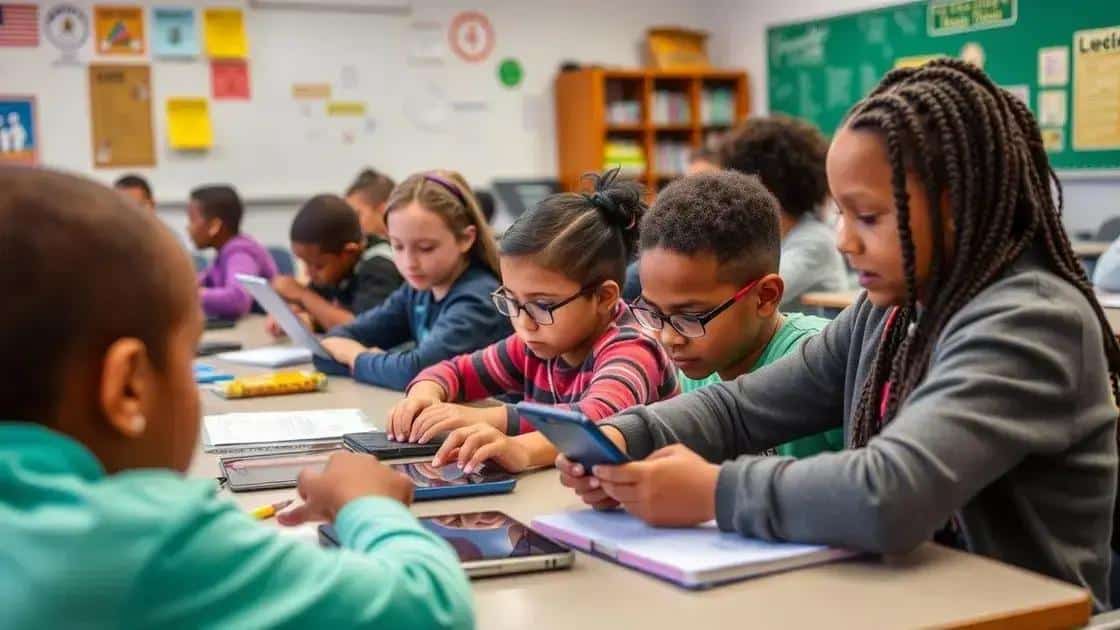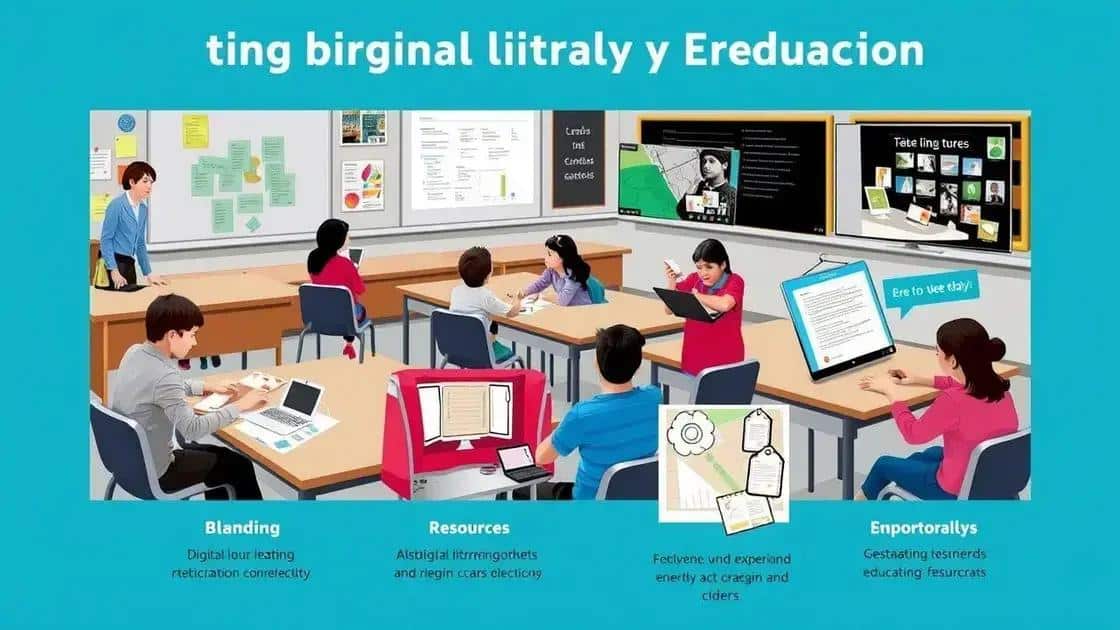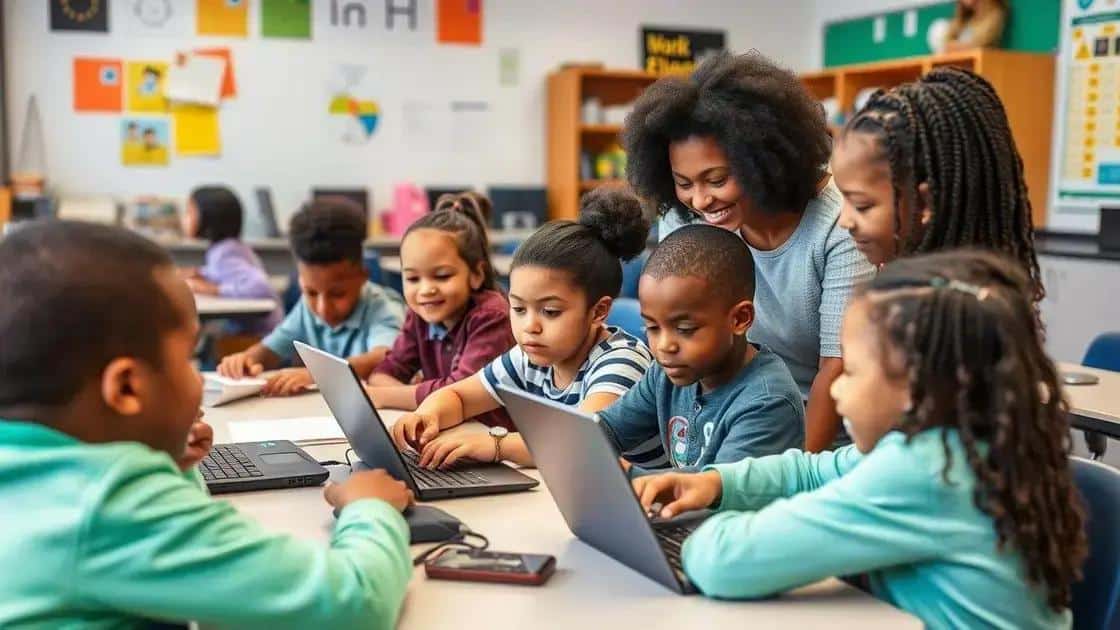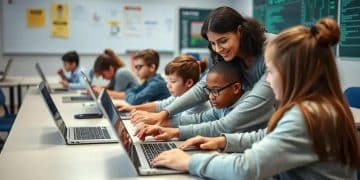Digital literacy curriculum trends you need to know

Inclusivity in digital literacy programs is crucial for ensuring all students have equal access to technology, allowing them to develop essential skills and succeed in an increasingly digital world.
Are you aware of the latest digital literacy curriculum trends? As technology evolves, so does the way we teach and learn. This article dives into key updates that can enhance educational practices.
Key components of digital literacy curriculums
Understanding the key components of digital literacy curriculums is essential for educators and students alike. These components form the foundation of effective teaching and learning in our tech-driven world.
Essential Skills
Digital literacy involves more than just knowing how to use technology. It encompasses several critical skills that students need:
- Information literacy: The ability to find, evaluate, and use information effectively.
- Communication skills: Understanding how to communicate and collaborate using digital tools.
- Technical proficiency: Knowing how to use various software and hardware proficiently.
Curriculum Integration
Integrating digital literacy within various subjects is essential. It enriches students’ learning experiences and prepares them for the future. For example, teaching digital presentations in a science class can enhance both tech skills and content understanding. Digital literacy shouldn’t be a standalone subject; it must be integrated into everyday learning.
Inclusivity is another vital component. Ensuring that all students, regardless of their background, have access to digital tools is crucial for developing a comprehensive digital literacy curriculum. Creating diverse learning environments allows for better engagement and understanding.
Teachers are encouraged to adapt the curriculum according to their students’ needs, focusing on real-world applications. This approach not only makes learning relevant but also exciting for students.
In addition, encouraging critical thinking and creativity through technology is vital. Students should learn to challenge information they encounter and use digital tools to express their ideas effectively. This process fosters a generation that is not just skilled in using technology but also capable of leveraging it for meaningful purposes.
Emerging trends in digital literacy education

As digital literacy education evolves, several exciting trends are emerging. These trends reflect the changing needs of students and society as technology advances.
Blended Learning Models
One major trend is the use of blended learning. This approach combines online digital media with traditional face-to-face teaching methods. Students can learn at their own pace, using technology to enhance their understanding of subjects. This flexibility can be especially beneficial for diverse learning styles.
- Personalized Learning: Students receive tailored educational experiences that meet their individual needs.
- Interactive Platforms: Engagement increases when students use games and apps in their learning.
- Flipped Classrooms: Students learn content at home and apply knowledge in class.
Focus on Soft Skills
Another emerging trend is the emphasis on soft skills, such as collaboration and critical thinking. Digital literacy programs are now incorporating these skills into their curriculums. Teachers encourage students to work together on projects using technology. This helps them learn how to communicate and solve problems effectively in real-world situations.
Technology is also being integrated into assessments. Instead of traditional tests, educators are using online quizzes and project-based evaluations. This change allows for a more accurate measure of a student’s understanding and abilities.
Furthermore, equity in access remains a hot topic. Many schools are striving to ensure all students, regardless of background, have access to necessary resources. This includes providing devices and internet access to underprivileged areas.
How schools are adapting to digital literacy
Schools today are actively adapting to digital literacy to meet the needs of their students. Understanding how to integrate technology into education ensures that students are prepared for the future.
Curriculum Redesign
One significant way schools are adapting is through curriculum redesign. Educators are incorporating digital skills into various subjects rather than treating them as a separate area. This approach allows students to see the relevance of technology in their daily lives.
- STEM Programs: Schools are emphasizing science, technology, engineering, and mathematics through hands-on projects.
- Digital Projects: Assignments often require students to use digital tools for presentations and collaborative work.
- Media Literacy: Understanding how to analyze digital content is becoming a core skill.
Professional Development for Educators
Another critical adaptation is the focus on professional development for teachers. Schools are investing in training programs to help educators become more comfortable with technology. This support equips teachers to effectively teach digital literacy skills.
Workshops, seminars, and peer mentoring are common strategies used. Teachers learn not only about new tools but also about best practices for integrating them into their existing frameworks.
Collaboration among educators is also key. Sharing experiences and resources can lead to innovative ideas for teaching. Schools encourage a culture of continuous learning, which benefits both teachers and students.
Furthermore, community engagement is vital. Schools invite parents and local businesses to participate in digital literacy initiatives. This partnership fosters a supportive environment for students and demonstrates real-world applications of their skills.
Importance of inclusivity in digital literacy programs

The importance of inclusivity in digital literacy programs cannot be overstated. As technology becomes essential in everyday life, it is crucial that all students have access to the tools and skills they need to succeed.
Equal Access to Technology
Inclusivity starts with providing equal access to technology. Schools must ensure that every student, regardless of their background, can use computers, tablets, and the internet. This is vital for helping students stay engaged in their education.
- Providing Devices: Schools should offer devices for students who may not have computers at home.
- Internet Connectivity: Efforts must be made to provide internet access in areas lacking reliable service.
- Support Resources: Programs that offer technical support can help students who struggle with technology.
Diverse Learning Environments
Creating diverse learning environments is another important aspect of inclusivity. Different students learn in different ways, and digital literacy programs should cater to various learning styles.
Utilizing a combination of hands-on activities, multimedia tools, and traditional teaching can enhance student understanding. Moreover, incorporating culturally relevant materials helps students relate more easily to the content.
Teachers can play a significant role by being open to feedback from students. Understanding individual challenges promotes a supportive atmosphere, encouraging students to thrive. Adjusting teaching methods according to student needs can lead to better engagement and learning outcomes.
Additionally, including parents and the community in digital literacy initiatives builds a support system for students. Workshops that teach parents about technology help them assist their children effectively. In turn, this creates a strong network around the student and reinforces the learning process.
In summary, ensuring inclusivity in digital literacy programs is essential for fostering a fair learning environment for all students. By providing equal access to technology and adapting teaching methods to meet diverse needs, schools can help every student thrive. Encouraging community involvement further strengthens this initiative, supporting students on their educational journey. Together, these efforts build a brighter future where everyone has the opportunity to succeed in the digital world.
FAQ – Questions about Inclusivity in Digital Literacy Programs
Why is inclusivity important in digital literacy programs?
Inclusivity ensures all students have equal access to technology, enabling them to develop essential skills for success.
How do schools provide equal access to technology?
Schools can provide devices and internet access to students who may not have these resources at home.
What role do teachers play in promoting inclusivity?
Teachers adapt their methods to meet diverse learning needs and foster a supportive environment for all students.
How can parents get involved in digital literacy initiatives?
Parents can participate in workshops and support their children by learning about the technology their kids use.





